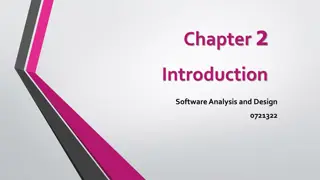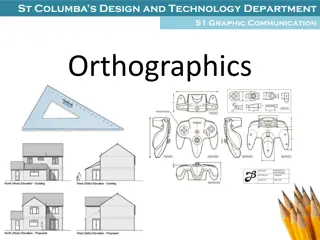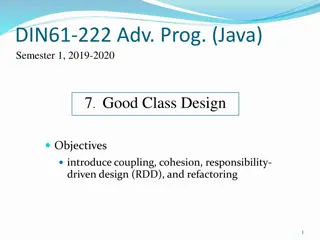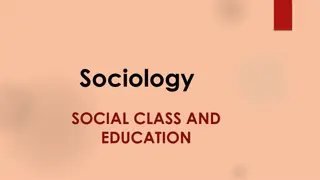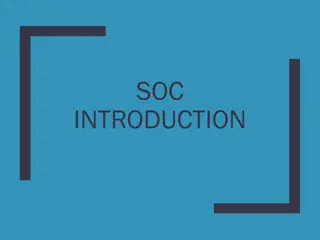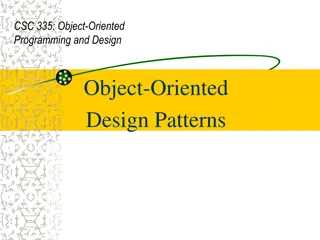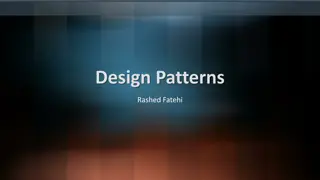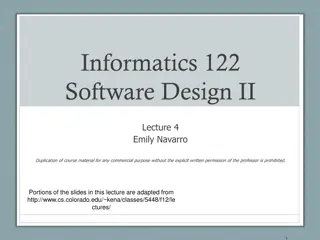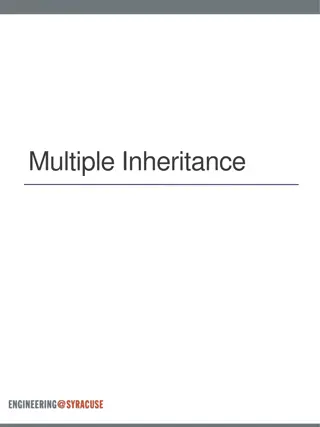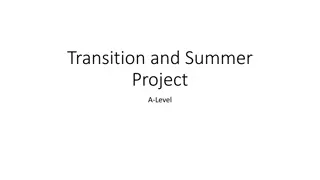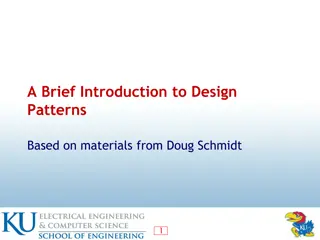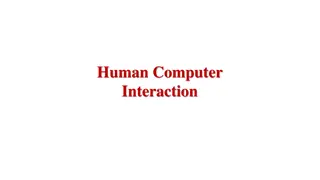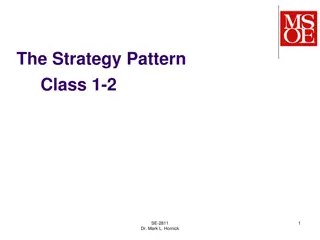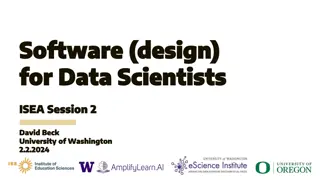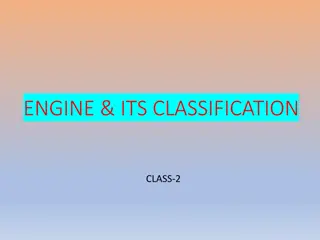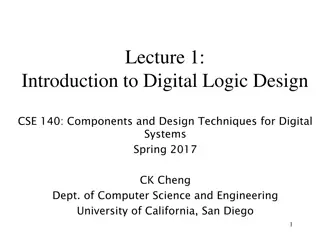Most recommended Solved CBSE Question Bank Class 10 French for language proficie
Together with CBSE Question Bank Class 10 Board Exam 2025 has been prepared as per the latest syllabus for Board Exams for Academic Session 2024-25. French Study Material Class 10 for exam 2024-25 is the best CBSE reference book with Section -wise Reading Material, MCQs, case\/source based questions
1 views • 1 slides
Object-Oriented Analysis and Design Workflow
Object-Oriented Analysis (OOA) is a crucial step in software development to produce a logical model of the system's functionality. It involves requirements analysis, use case analysis, and use case realization to identify classes, responsibilities, attributes, and associations. The process includes
11 views • 90 slides
Software Analysis and Design Process
Software analysis and design involve a systematic approach to understanding user requirements, creating logical models, and transitioning to detailed design specifications. Requirements analysis focuses on capturing system requirements, while design translates these requirements into implementation
8 views • 16 slides
Overview of Antiarrhythmic Drugs Use and Classification
Antiarrhythmic drugs are classified into different classes based on their mechanisms of action. Class I includes sodium channel blockers with specific drugs like procainamide, disopyramide, and quinidine. Class 1B involves lidocaine and mexiletine. Class 1C consists of agents like flecainide. Class
2 views • 19 slides
Get the Best Toddler Music Class in Marine Parade
Get the Best Toddler Music Class in Marine Parade at The Music Scientist Pte Ltd! They offer a unique music school and movement program for pre-schoolers that integrates enriching general knowledge for children. Their classes include children's music class, toddler music class, and baby music class.
1 views • 6 slides
Social Class and Consumer Behavior
Explore the concept of social class and its impact on consumer behavior across different socioeconomic groups. From subjective to objective measurements, learn how lifestyle choices vary between upper class elites, high-level professionals, and the middle class. Discover how social class influences
0 views • 11 slides
Guidelines for Design of Cement Concrete Pavement and Interlocking Paver Blocks
This document provides guidelines for designing cement concrete pavements and interlocking paver blocks, covering factors governing design, wheel loads, design period, subgrade characteristics, approximate k values based on CBR values, and the importance of a sub-base below concrete pavements. It em
0 views • 67 slides
Object-Oriented Design in Software Development
Learn about the concept of object-oriented design in software development, including the importance of design, the structure of objects, building objects, and what a class typically looks like. Discover how design facilitates building scalable systems and fostering collaboration within development t
1 views • 21 slides
Orthographic Drawing in Design and Technology Education
Delve into the world of orthographic drawing through St. Columba's Design and Technology Department's S1 Graphic Communication program. Discover the significance of orthographics in visualizing 3D objects as 2D drawings, learn about orthographic views like Elevation, Plan, and End Elevation, and exp
0 views • 8 slides
Software Engineering Design Principles and Concepts
The chapter discusses the essential principles and concepts in software design, highlighting the four key design models - data design, architectural design, interface design, and component-level design. It emphasizes the importance of traceability to the analysis model, minimizing the gap between so
2 views • 36 slides
Class Design in Java Programming: Coupling, Cohesion, RDD, and Refactoring
Delve into the world of Java programming with a focus on class design principles such as coupling, cohesion, responsibility-driven design (RDD), and refactoring. Understand the importance of good design for code quality, ease of debugging, maintenance, and reusability. Dive into the adventure of Zuu
0 views • 39 slides
Social Class and Education Through Sociology
Explore the dynamics of social class and education through the lens of sociology. Delve into the historical context of poverty in the UK, the impact of social class inequality, and the complexities of defining and categorizing social class. Learn about Bourdieu's theory on different types of capital
0 views • 12 slides
System on Chip (SoC) Design and Components
Explore the world of System on Chip (SoC) design, components, and working flow. Learn about Intellectual Properties (IP), platform-based design, typical design flows, top-down design approach, and the emerging Electronic System Level (ESL) design flow. Discover the essential components of an SoC, su
0 views • 45 slides
Design Inspiration and Elements in Costume and Fashion Design
Dive into the world of costume and fashion design through a visual journey of finding design inspiration, understanding the design process, emphasizing originality, and exploring different sources of creativity. Discover how technology, art, food, history, architecture, and nature can spark innovati
0 views • 45 slides
Enhancing Piping Design Efficiency with Spec-Driven Technology
Explore how Spec-Driven Piping technology powered by CADACTIVE offers a standardized approach for piping design in Creo Parametric. This innovative extension streamlines design communication, eliminates errors, and improves design efficiency by utilizing a master catalog, automated checking capabili
0 views • 15 slides
Challenges Faced by Working-Class Millennials in the Neoliberal Era
Working-class Millennials experience delayed adulthood due to disappearing jobs, fragile families, and shrinking social supports. The research examines how economic instability shapes their adult selves, American Dream understanding, and failures to enter the middle class. Methods include in-depth i
0 views • 12 slides
Material Design: Combining Classic Design Principles with Technological Innovation
Material Design is a design language that combines traditional design principles with the possibilities offered by technology and science. It emphasizes visual language, classic design elements, and innovation to create delightful user experiences. The Material Metaphor, Imagery, Typography, Color,
0 views • 34 slides
Comprehensive Guide to System Design Components and Techniques
System design involves the detailed planning and identification of components in an information system, aiming to provide users with a general understanding of the new system. This process includes techniques like flowcharts, prototyping, and component design, covering aspects such as output design,
0 views • 24 slides
Overview of Object-Oriented Design Patterns in Software Development
In the realm of software development, object-oriented design patterns play a crucial role in structuring code and solving recurring problems efficiently. These patterns, as outlined in various influential books and resources, provide a systematic approach to design, encompassing aspects like object
0 views • 26 slides
Design Patterns: A Comprehensive Overview
Exploring the world of design patterns, this content delves into the essence of design patterns, their application in software design to resolve complexity, and the different types of design patterns - creational, structural, and behavioral. It also showcases examples of popular design patterns such
0 views • 22 slides
Software Design Patterns: Understanding Core Solutions
Explore the world of software design patterns in this lecture, delving into fundamental principles, checklists for overall design, class design, principles, and strategies. Learn how design patterns offer reusable solutions to common problems, enhancing your ability to create efficient and adaptable
0 views • 54 slides
Basic Concepts in Software Design
Software design involves transforming customer requirements into a form suitable for implementation, with activities categorized into preliminary and detailed design stages. High-level design focuses on module identification and control relationships, while detailed design entails defining data stru
1 views • 24 slides
Multiple Inheritance in Object-Oriented Programming
Multiple inheritance in object-oriented programming allows a derived class to inherit from more than one base class, creating a unified derived class. This design structure is suitable when the base classes are orthogonal and have no common attributes or behaviors. The derived class logically combin
0 views • 14 slides
3D Design and Critical Analysis in Architecture
Dive into the world of 3D design and critical analysis with a focus on architecture. Discover the stages of design, essential skills for designers, and areas of study in three-dimensional design. Delve into iconic buildings like Frank Lloyd Wright's Falling Water, analyze their key features, and eve
0 views • 9 slides
Design Patterns in Object-Oriented Design
Design patterns in object-oriented design (OOD) are essential templates that codify best practices for solving common problems. They help streamline development by capturing proven design decisions, promoting code reuse, and enhancing system flexibility and modularity. Learn about the core concepts,
0 views • 20 slides
Metrics and Lessons Learned for Object-Oriented Projects
This chapter discusses various metrics and lessons learned for object-oriented projects, including the use of major OO metrics, Lorenz's metrics, IBM's Object Oriented Technology Council recommendations, and the CK metrics suite. The CK metrics suite covers six OO design and complexity measures, suc
0 views • 17 slides
Introduction to Biblical Hebrew Vowels: A Comprehensive Overview
Exploring the development and significance of Hebrew vowels in Biblical texts, this visual guide covers the evolution of vowel systems, the roles of the Masoretes in adding vocalization marks, and the distinctions between a-class, e-class, i-class, o-class, and u-class vowels. Delve into the nuances
0 views • 28 slides
Interaction Design in Human-Computer Interaction
Interaction design focuses on creating interactive products that are easy, effective, and enjoyable to use. It aims to reduce negative user experiences while enhancing positive ones. Designing interactive products requires understanding user activities, interfaces, and device arrangements to support
0 views • 11 slides
SE2811 Software Component Design Overview
This course covers software component design, design patterns, object-oriented design, algorithms, and opportunities for reuse in systems design. It emphasizes the importance of domain-level design and provides insights into solving core problems through reusable classes.
1 views • 21 slides
Analysis of Bunch Lengthening in CEPC for Different Design Parameters
This study explores bunch lengthening in the Circular Electron Positron Collider (CEPC) for various design parameters, analyzing a 54 km design scheme, a 61 km design scheme, and a 100 km design scheme. The analysis includes the theoretical framework used, equations for bunch lengthening, and conclu
1 views • 15 slides
Plain & Reinforced Concrete Structures in Design Engineering
In the design of Plain & Reinforced Concrete structures, various strength design methods such as Ultimate Strength Design (USD) and Allowable Strength Design (ASD) are utilized. These methods involve factors of safety, material strength, load factors, and analysis in the elastic range. Additionally,
0 views • 11 slides
British Class System and Migration to Former Colonies
The British class system categorizes individuals based on wealth, education, and occupation into working class, middle class, and upper class. Migration to former colonies like Canada played a significant role in shaping the demographics and cultural richness of these countries. The decision to immi
0 views • 13 slides
Verilog Adder Examples & Typical IC Design Flow
This comprehensive content delves into Verilog adder examples, typical IC design flow, physical design considerations, and examples of OpenGL ES GPU and ARM hypervisor applications. It covers the fundamentals of digital logic with Verilog design, hardware description language, FPGA prototyping, phys
1 views • 27 slides
The Strategy Design Pattern
The Strategy Design Pattern is a behavioral pattern that helps in encapsulating behaviors and varying them as attributes to avoid implementation inheritance and class explosions. By decoupling strategies from the main functionality, it allows for flexibility and ease in changing algorithms at runtim
1 views • 21 slides
The Importance of Software Design for Data Scientists
Today's ISEA Session 2 with David Beck from the University of Washington delves into the critical role of intentional software design for data scientists. The session covers the software design approach, user-centric design stories, use cases, components, testing strategies, and the benefits and dra
1 views • 76 slides
Engine Classification and Design
Engine classification involves categorizing engines based on various factors such as combustion type, number of strokes, cylinder design, and ignition method. Common classifications include external and internal combustion engines, as well as categories based on the design and use of the engine. Add
0 views • 11 slides
Efficiency Tradeoff Between Class Adjudication and Individual Arbitration
Efficiency tradeoff between class adjudication and individual arbitration analyzes the enforcement of individual arbitration over class actions in the United States, highlighting the defense bar's advocacy for class action waivers and arbitration of individual claims. The Federal Arbitration Act's i
0 views • 9 slides
Social Class in Sociology
Social class, also known as class, refers to a group of individuals in a society who share similar socioeconomic status. The concept of class plays a crucial role in social theory, influencing social mobility and census data. From early theories by political philosophers like Hobbes to Marx's influe
0 views • 17 slides
Introduction to Digital Logic Design - CSE 140 at UCSD
This content provides information about the Introduction to Digital Logic Design course (CSE 140) at the University of California, San Diego for the Spring 2017 semester. It includes details about the instructor, TAs, tutors, websites, textbooks, grading policy, logistics, and class materials. The c
0 views • 38 slides
Hitachi Zaxis ZX135US-3 class ZX225US-3 class ZX225USR-3 class Hydraulic Excavator Operator’s Manual Instant Download (Part No.EM1U4-2-1)
Hitachi Zaxis ZX135US-3 class ZX225US-3 class ZX225USR-3 class Hydraulic Excavator Operator\u2019s Manual Instant Download (Part No.EM1U4-2-1)
0 views • 29 slides


